Pierre Bonnard Biography
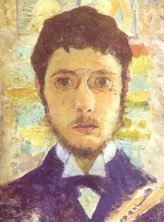
Pierre Bonnard was born October 3, 1867 at Fontenay-aux-Roses, near Paris, into the family of a high-ranking official in the French War Ministry. After an idyllic and happy childhood, in 1886, Pierre entered the University of Paris to study law.
In 1887, he also enrolled for evening classes at the Académie Julian, a liberal Parisian art school, where he made friends with Paul Sérusier (1864-1927), Mauris Denis (1870-1943), Henri Ibels (1867-1936) and Paul Ranson (1862-1909). The five friends formed a society known as Nabiim or the Nabis after the Hebrew for'prophets'.
After graduating from the University, Bonnard was obliged to train as a civil servant in the Paris Registry Office from 1888. At the same time he entered the Ecole des Beaux-Arts, an academic institution with a solid reputation. Evidently the Ecole did not contribute much to Bonnard's artistic development, but there he made friends with Ker-Xavier Roussel (1867-1944) and Edouard Vuillard (1868-1940), who were both initiated into the Nabis.
In 1889, Bonnard won a competition to design a poster advertising French champagne. Revolutionary in its manner this poster greatly influenced Toulouse-Lautrec (1864-1901), whose famous posters of the end of the 19th century were created in the same innovative style.
After failing his civil service examination and a six-month military service, which followed, Bonnard rented his first studio with his father's consent. Bonnard exhibited paintings at the Salon des Indépendants from 1891. In the autumn of the same year he took part in the first exhibition of the Nabis in the Gallery of Le Barc de Boutteville. He worked much in all directions; apart from paintings, Bonnard designed furniture and textile patterns, painted screens and stage sets and made puppets for puppet shows, illustrated books. His friends nicknamed him ‘a highly Nipponized Nabi’, because his individual style at that time developed under a strong influence of Japanese prints.
In 1893, he met 16-year-old Marthe de Méligny, of whose real name of Maria Boursin Bonnard was not aware of until they got married 32 years later. From their meeting a large part of his art revolved around her. His paintings of the late 1890s are very personal and intimate, e.g. Indolence (1899), Man and Woman (1900).
From 1900, the artist started spending more and more time out of Paris, in the countryside between Paris and Normandy. His numerous landscapes of the period are influenced both by the Impressionists and Gauguin. From 1906, Bonnard began to have annual one-man exhibitions, the Bernheim-Jeune art-dealing firm signed an exclusive contract for the exhibition of his works. While his compositions and brushwork remained'traditionally Impressionistic', close to Degas', he gradually developed his own style, enriching the Impressionist color palette.
The newest artistic developments in Paris did not interest Bonnard. Fauve painting, Cubism, and other'isms' had no influence on him. The best known of his works of the period are panels commissioned by Misia Godebska in Paris (1910) and the triptych The Mediterranean done for the Moscow residence of Ivan Morozov in 1911.
During the years before the First World War he traveled much in Europe and North Africa, (Spain, Belgium, Holland, England, Italy, Germany, Algeria and Tunisia) but it's difficult to find any impact of these travels in his art. During the war he exhibited little. And again, apart from several war-themed sketches, there is no trace of this colossal conflict in his works. It seems he painted from his happy childhood, his art is personal and intimate and the 20th century is absent. The tranquility of his painted world is not disturbed by the events of real life.
In 1918 he was made the honorary president of a society of young French painters.
In 1926 Bonnard bought a house named'Le Bosquet' at Le Cannet on the Côte d'Azur. The house remained his main place of residence and work until his death. The same year, 1926 year, he visited the USA.
His works of the 1920s and 1930s were called "meditative masterpieces" by some critics.
In 1937 he was honored with the responsibility of decorating the French pavilion at the Exposition Universelle in Paris. According to his own opinion he failed to create something worthy on the large surface.
In his old age, Bonnard returned to the youthful exuberance of dazzling light and color, producing compositions of exquisite taste. During the Second World War he lived in Le Bosquet, and continued living there as a recluse after his wife’s death in 1942. In 1945, he paid his last visit to Paris. On January 23, 1947 Bonnard died.
Bibliography
Pierre Bonnard. By N.V. Yavorsky. Moscow. 1972.
French Painting from the Hermitage, Leningrad. Mid-19th to early 20th century. Aurora. Leningrad. 1975.
Painting of Europe. XIII-XX centuries. Encyclopedic Dictionary. Iskusstvo. 1999.
Pierre Bonnard: Observing Nature by Pierre Bonnard, Gloria Groom (Contributor), Ursula Perucchi-Petri (Contributor), Belinda Thomson, Jorg Zutter (Editor). National Gallery of Australia, 2003
Bonnard: Shimmering Color by Antoine Terrasse (Author), Laurel Hirsch. Harry N. Abrams, 2000.
Bonnard by Nicholas Watkins (Author). Phaidon Press Inc., 1996.
Interpreting Bonnard: Color and Light by Nicholas Watkins. Stewart, Tabori & Chang, 1998.
- France-Champagne.
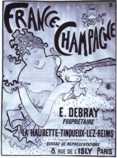
1891. Lithograph in 3 colors.
- Indolence.
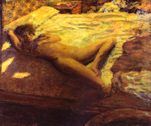
c.1899. Oil on canvas. 92 x 108 cm. Private collection.
- Man And Woman.
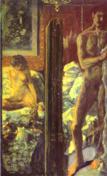
1900. Oil on canvas. 115 x 72. Musée d'Orsay, Paris, France.
- The Mediterranean. Triptych.

1911. Oil on canvas. cental pamel 407x152 cm; side panels 407x149cm each. The Hermitage, St. Petersburg, Russia.
- Self-Portrait.
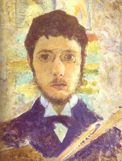
c.1889. Tempera on canvas. 21.5 x 15.8 cm. Private collection.